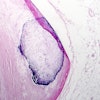Monday, December 1 | 10:50 a.m.-11:00 a.m. | SSC12-03 | Room S403B
This study from the Mayo Clinic in Rochester, MN, showed that increasing the difference in the x-ray spectra in dual-energy CT increases image quality, and that this improvement can be translated into reductions in dose."There is a naive belief that by performing a dual-energy CT exam, one can create a virtual noncontrast set of images, thereby omitting the true noncontrast scan phase and eliminating one phase of a multiphase exam (thereby reducing the dose of the exam as a whole)," wrote Cynthia McCollough, PhD, in an email. "However ... the image quality of the virtual no-contrast scan is not the same as the true noncontrast exam."
Previously, the image quality of virtual noncontrast images was so low that significant dose savings weren't really possible, but that is starting to change.
"With increased spectral separation, the virtual noncontrast images are much closer to true noncontrast, and one can potentially reduce exam dose by up to 40%," she explained.
The study aimed to determine the dose efficiency of virtual noncontrast imaging from various kV combinations in dual-energy (DE) CT if it were to replace the true noncontrast scan. The group also wanted to select the optimal kV combination for different patient attenuation levels.
To determine the optimal dual-energy kV combination used for each phantom size, the noise power spectrum at each lower kV was measured and compared with a reference single-energy 120-kV scan, and artifacts caused by photon starvation, if any, were also analyzed.
The optimal DE kV combination was determined for different phantom sizes. The dose reduction achievable by virtual noncontrast images was found to increase with greater separation of the spectra between low- and high-kV x-ray beams.
For example, with a 25-cm phantom for which all kV are applicable, the dose reductions ranged from 10% to about 40%. This presentation will discuss dose reductions for all phantom sizes.




















